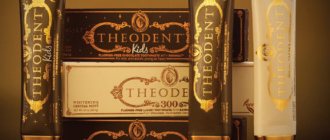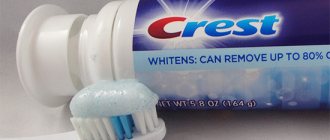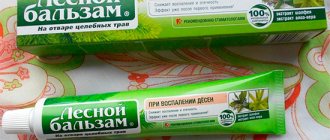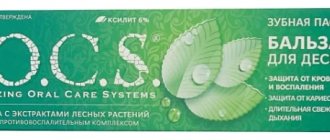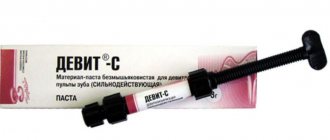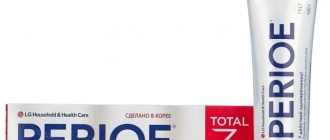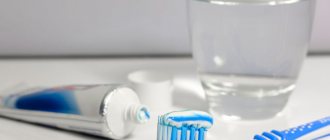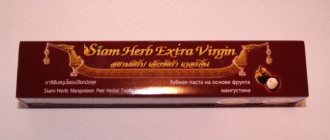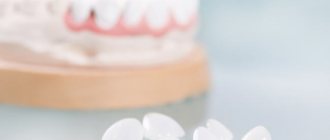Competent and thorough oral hygiene is an integral part of caring for your health and appearance. Agree, a beautiful, shining white smile immediately catches the eye and wins over your interlocutors. And if fresh breath and a great mood are added to snow-white teeth, communication will be guaranteed to be pleasant.
However, modern people are increasingly concerned about bad breath, dark plaque on the teeth, caries and various tissue inflammations. To prevent all these problems from affecting you, it is important to take effective care of your oral cavity by using antibacterial toothpaste.
In the beginning there was sand and chalk
Toothpaste and brush are everyday things with which our day begins and ends. However, they were once a real luxury. The ancient Egyptians were the first to think about oral hygiene and began to use sand, ash, ground stones and animal horns as a cleaning agent, and their own finger replaced the brush. In the 4th century BC. The great healer Hippocrates recommended using mixtures of pumice with the addition of wine vinegar, which are more gentle on tooth enamel, to prevent dental diseases. At the end of the 18th century, little had changed. For example, the British brushed their teeth with powders that included crushed brick, crushed bark and coal chips.
The prototype of modern toothpaste was invented by Americans in the 19th century. This time there were no stones or ash. Teeth cleaning products were a mixture of chalk powder, neutral soap and aromatic additives. It was only in 1873 that Colgate released the first toothpaste in glass jars, which replaced tubes two decades later. They were invented by dentist Washington Sheffield of New London. But Colgate beat the inventor by quickly registering a patent for itself. An interesting fact is that in Russia, most people at that time continued to brush their teeth with chalk-based powder, and only in the 50s it became possible to buy a familiar tube of toothpaste in stores.
What inflammations can bacteria cause?
Everyone knows that bacteria are the main cause of inflammatory processes in the oral cavity. Normally, we have aerobic microflora in our mouth, which takes part in the primary processes of food digestion, absorption of nutrients and vitamins.
But when foreign bacteria begin to displace beneficial bacteria and settle in their place, various diseases of the teeth and gums appear.
Caries is considered to be the most common dental problem. Almost everyone has encountered this disease. Caries appears as small faded spots on the enamel. These stains darken over time and the tooth begins to decay.
Common causes of caries are insufficient oral hygiene, improper, unbalanced diet, and sometimes oral trauma.
Superficial caries is accompanied by increased sensitivity of the enamel, deep caries is accompanied by the appearance of visible holes in hard tissues and more acute pain. Children often develop bottle caries due to prolonged use of pacifiers and pacifiers, as well as retention of food debris in the mouth after night feedings.
The consequence of untreated deep caries is most often pulpitis. The damage reaches the dentin, and then to the pulp chamber, which contains the neurovascular bundle. In rare cases, the pulp becomes inflamed due to infection carried through the bloodstream from other organs.
Pulpitis is characterized by severe pain, and sometimes by pus and fever.
Another common problem is a dental cyst or inflammatory process, which is characterized by the growth of tissue near the root. Most often, the cyst is provoked by pulpitis and periodontitis. The cyst is accompanied by swelling of the gums and severe pain.
Sometimes advanced pulpitis develops into periodontitis, inflammation of periodontal tissue, the structure that holds the roots of the teeth in the alveolus of the jaw. This complex disease provokes tooth mobility, purulent inflammation and even fever.
Other common oral diseases are:
- Periodontitis is an inflammation of the periodontium, which is manifested by bleeding gums and accumulation of pus in periodontal pockets.
- Periodontal disease is the loss of connection between the root and the jaw due to atrophy of the dental process of bone tissue. With periodontal disease, pus begins to accumulate in the periodontal pockets, the neck of the teeth is gradually exposed, which can provoke complete tooth loss.
The main cause of diseases of the teeth and gums, as a rule, is improper oral hygiene, ignoring antibacterial toothpastes and antibacterial rinses, and irregular teeth brushing. Sometimes diseases are provoked by infectious diseases, in which pathogenic bacteria penetrate into the dental tissues from the oral cavity, in which inflammation occurs, through cracks in the crowns or through the bloodstream from a diseased, infected organ.
Doctors include other causes of oral pathologies:
- poor nutrition and, accordingly, insufficient supply of nutrients to dental tissues;
- taking medications;
- excessive intake of certain elements into the body (for example, fluoride);
- metabolic disorders, hormonal shifts;
- reduced immunity;
- oral injuries;
- congenital anomalies of the dentition;
- hereditary predisposition to dental diseases;
- exposure to chemicals and radiation, working in hazardous industries or living in contaminated areas.
Best toothpaste
Which toothpaste is better? Definitely one that meets a person’s needs and suits his indications. Until recently, the main task of toothpaste was to help the brush clean teeth from plaque. Today, modern manufacturers of hygiene products have expanded its functionality and began to offer special medicinal toothpastes, both complex and for targeted solutions to specific problems. Today you can find tubes not only for the prevention of caries, but also for bleeding gums, against the formation of tartar, paste for implants or smoker’s plaque, for fresh breath or restoring the pH balance of the oral cavity, as well as for much more. But, in fact, all pastes are divided into several varieties, which we will consider.
Clinical researches
The products in the Asept line have proven clinical effectiveness and are therefore sold in pharmacies. For example, multiple clinical studies have proven that regular use of preventive toothpaste ASEPTA ACTIVE for a month can reduce bleeding gums by 60%, improve the overall condition of the oral cavity by 44% and reduce inflammation by 33%.
Sources:
- Report on determining/confirming the preventive properties of toothpaste “ASEPTA PLUS” GENTLE WHITENING” Author: doctor-researcher A.A. Leontyev, head Department of Preventive Dentistry, Doctor of Medical Sciences, Professor S.B. Ulitovsky First St. Petersburg State Medical University named after. acad. I.P. Pavlova, Department of Preventive Dentistry
- Clinical and laboratory assessment of the influence of domestic therapeutic and prophylactic toothpaste based on plant extracts on the condition of the oral cavity in patients with simple marginal gingivitis. Doctor of Medical Sciences, Professor Elovikova T.M.1, Candidate of Chemical Sciences, Associate Professor Ermishina E.Yu. 2, Doctor of Technical Sciences Associate Professor Belokonova N.A. 2 Department of Therapeutic Dentistry USMU1, Department of General Chemistry USMU2
- Report on the determination/confirmation of the preventive properties of personal oral hygiene products “ASEPTA PLUS” Remineralization doctor-researcher A.A. Leontyev, head Department of Preventive Dentistry, Doctor of Medical Sciences, Professor S.B. Ulitovsky First St. Petersburg State Medical University named after. acad. I.P. Pavlova, Department of Preventive Dentistry
- Clinical studies of antisensitive toothpaste “Asepta Sensitive” (A.A. Leontyev, O.V. Kalinina, S.B. Ulitovsky) A.A. LEONTIEV, dentist O.V. KALININA, dentist S.B. ULITOVSKY, Doctor of Medical Sciences, Prof. Department of Therapeutic Dentistry, St. Petersburg State Medical University named after. acad. I.P. Pavlova
Pastes for the prevention of dental caries
Toothpastes for the prevention of caries are recommended for increased susceptibility to the formation of caries bacteria, as well as as restorative therapy after teeth whitening. They saturate dental tissues with useful minerals, prevent the growth of carious bacteria, and also fight the formation of plaque. To strengthen teeth, fluoride compounds are added to such pastes. It is contained in such pastes as “Day and Night” Swiss Smile, Enzycal 950 CURAPROX, Mirafluor C Miradent, “Power of a Smile” Jason and others. Fluorine is an important microelement, since it is the one that participates in the metabolism of calcium, and, therefore, ensures its presence in the enamel. But it is worth remembering that it is extremely toxic, so its amount entering the body should not exceed the established norm. People living in areas with fluoride-saturated water (more than 1.2 mg/l) are advised to use fluoride-free toothpaste. You can find out about the fluoride content in the water in your area by calling the nearest Sanitary and Epidemiological Station.
Toothpaste
Theodent Classic
Mineral salts
Mineral salts and their complexes added to toothpastes have a beneficial effect on the oral mucosa, help improve blood circulation, dissolve mucus, and prevent the formation of soft plaque. Salts are able to maintain the acid-base balance, normalizing metabolic processes, alkalizing the oral cavity and, creating an optimal environment for enamel mineralization processes, stimulate salivation, thus ensuring the implementation of the protective and buffering functions of saliva. Some of the salt additives contain macro- and microelements that can be included in the hard tissues of the tooth. The high concentration of salts in pastes causes an increased outflow of tissue fluid from the inflamed gums, and also has some analgesic effect.
Toothpastes contain sea salt and table salt. Mineral waters rich in salts and brine from the Pomorie estuaries are used, which also improves the blood supply to periodontal tissues and their trophism. Sodium bicarbonate (baking soda) is a mild abrasive that neutralizes the acidic activity of bacteria.
Salt-containing toothpastes
indicated for significant formation or tendency to form non-mineralized dental plaque, chronic inflammatory diseases of the periodontium and oral mucosa, increased viscosity of saliva, hyposalivation.
Pastes against tooth sensitivity
There are special toothpastes for sensitive teeth. They contain potassium chloride, potassium citrate (Twin Lotus Recipe for Sensitive Teeth, Mirasensitive hap+) or strontium chloride. These substances “clog” the dentinal tubules and reduce hyperesthesia. They also saturate the tooth enamel with minerals, the deficiency of which is most often the cause of increased sensitivity of enamel and dentin. But the most progressive substance today is considered to be hydroxyapatite (Sensitivity Control Biorepair). Its crystals are similar in composition to tooth enamel, so they effectively combine with it, restoring the natural protection of teeth. Pastes for sensitive teeth should not contain a drop of chemical bleaches and, instead of coarse calcium carbonate, should contain gentle abrasive substances with a smaller particle diameter, for example, silicon oxide. Such pastes are recommended for hypersensitive teeth, as well as for use during and/or after teeth whitening procedures.
Sensitivity Control Biorepair toothpaste
Pastes for strengthening gums
Toothpastes aimed at preventing and reducing periodontal inflammatory processes reduce bleeding gums, help strengthen them, have an astringent effect, and also destroy harmful microbes. They most often contain antibacterial substances, for example with chlorhexidine, as in Curaprox ADS 712 paste, together with plant extracts that have an anti-inflammatory effect, such as edelweiss and echinacea in the SWISS SMILE vitamin herbal paste or witch hazel and calendula in the Plus Parodontgel BioRepair paste. Some of them also contain chlorophyll and vitamin E. All of these substances have a beneficial effect on gum tissue, accelerating the healing process and the formation of new cells. Such pastes are recommended for diseases of stomatitis, gingivitis and periodontitis.
Toothpaste Curasept ADS 712 CURAPROX
What is the effect of titanium dioxide on the body?
For a long time it was believed and is still believed at the official level that this compound is absolutely inert and does not linger in the body. Therefore, under the name “additive E171”, it is generously added both to hygiene products and food products - yoghurts, marshmallows, crab sticks, etc.
But a study by Chinese scientists suggests that titanium dioxide particles penetrate from the gastrointestinal tract into other organs and damage the liver and kidneys. And scientists from the USA discovered that this substance has a negative effect on the cells of the brain and nervous system, causing their diseases.
Pastes against bad breath
The action of toothpastes that help fight halitosis is aimed at restoring the normal balance of oral microflora, the disruption of which is usually accompanied by excessive proliferation of anaerobes. These substances emit volatile sulfur-containing products that have a pungent odor. Anti-bad breath pastes contain components that suppress pathogenic microflora and act on viruses. In addition, such pastes eliminate dry mouth syndrome, which can also cause halitosis. Antihalitic hygiene products are recommended for bad breath caused by microflora disturbances and dry mouth.
Enzymatic toothpaste gel
Jason Enzyme Brightening
Features of antibacterial agents
Pathogenic bacteria multiply in the oral cavity through the interaction of food debris with saliva. When caring for healthy teeth, daily hygiene using traditional toothpastes is sufficient. Specialized formulations are recommended by dentists when the following problems occur:
- gingivitis;
- periodontitis;
- caries.
Antibacterial products help cope with pathogenic microorganisms that cause the development of diseases. It has anti-inflammatory and antiseptic effects. Thanks to this, it promotes rapid wound healing and recovery after dental surgery.
To achieve a positive effect, antibacterial cleaning is not enough. Therefore, the active formula of toothpastes includes additional components for comprehensive oral care. Most often used in the composition:
- chlorine dioxide;
- propolis;
- triclosan;
- aloe extract;
- chlorhexidine;
- zinc;
- silver molecules;
- Eucalyptus oil.
Composition of toothpaste - which is better?
A dental hygienist can help you figure out which toothpaste is best for specific oral problems. When purchasing a product yourself, you need to pay attention to whether it contains substances potentially harmful to teeth. For example, coarse abrasive substances that negatively affect tooth enamel. These may be chalk or calcium carbonate, as well as aluminum oxides, which are prohibited in some countries. Nowadays, silicon dioxide is considered the best abrasive; it gently removes all dental plaque without having a negative effect on the enamel and gums. You can also find other safe abrasive substances in paste compositions—dicalcium phosphate or sodium metaphosphate.
You should be careful with toothpastes that contain triclosan or chlorhexidine. Brushing with such pastes may be necessary to treat inflammation in the gums or to eliminate bad breath. However, long-term use (more than 3 weeks) of paste with antibacterial substances can lead to disruption of the beneficial microflora of the oral cavity. If sodium lauryl sulfate is in one of the first places in the description of the composition (that is, its percentage is large), then it is also better not to buy such a paste. The fact is that this surfactant is responsible for foaming, but does not in any way affect the quality of cleaning. In addition, it has long been proven that even in small doses, sodium lauryl sulfate can negatively affect the body. This component is contained in all pastes from Blend-a-med, Colgate, Oral-B, Aquafresh, Karimed, Forest Balsam, some pastes from Lacalut, SPLAT, PresiDENT, and New Pearl.
Therapeutic and prophylactic toothpastes for every day with natural ingredients
Toothpaste is designed to cleanse the oral cavity of food debris, suppress the growth of pathogenic microorganisms, thereby preventing the destruction of tooth enamel, inflammation of the mucous membranes and gums of the oral cavity, and contain components of “nutrition” and strengthening of the components of the oral cavity.
Toothpaste for preserving gums (prevention of periodontitis and periodontal disease) and maintaining pH balance in the oral cavity.
There are no age restrictions for use. (https://nspclub.org/?a=291 ( SECTION: NSP products SUB-SECTION: Toothpastes)
Toothpaste for natural protection of tooth enamel from cariogenic bacteria and maintaining pH balance in the oral cavity. (https://nspclub.org /?a=206 ( SECTION: NSP Products SUB SECTION: Toothpastes)
Since toothpaste is the main means of hygiene of the oral mucosa, it must meet a number of specific requirements:
- be safe for the mucous membranes and the body;
- It is good to remove plaque without damaging the gums and tooth enamel;
- prevent plaque from occurring;
- influence the mineralization of teeth;
- strengthen the protective functions of the oral mucosa;
- have antimicrobial and periodontal protective properties;
- have a deodorizing and refreshing effect.
Throughout his entire adult life, a person on average “absorbs” from two to five kilograms of toothpaste! Scientists have found that young children reflexively swallow about 40% of toothpaste when brushing their teeth. It is important to understand that from the oral cavity, thanks to the mucous membrane, iodine, copper, iron, potassium, fluorine, sodium, zinc, vitamins, amino acids, etc., if they are components of toothpaste, enter the bloodstream in a matter of seconds. Thus, beneficial substances penetrate into the oral mucosa, then into the blood capillaries, then into the pulp of the tooth, and from the pulp into the enamel. But along with useful substances, we also “eat” antibiotics (triclosan, chlorhexedine, hexedine, metranidazole), flavorings, sweeteners (potassium acesulfate, sodium cyclomate, aspartame), sodium lauryl and laureth sulfate.
It is the composition of the toothpaste that determines how long we can use this or that toothpaste without harm to the body. The ingredients of chemical synthesis of toothpaste efficiently remove plaque accumulating on enamel, effectively suppress pathogenic microflora, and have good whitening properties. Active chemical components act quickly, which is an important advantage, but at the same time they are not able to fully “nourish” the gums and adjacent tissues, restore them, soothe and protect them. Moreover, with prolonged use of an artificial composition, the microflora becomes accustomed to synthetic substances, as a result of which the anti-inflammatory properties and, accordingly, the effect of use are reduced. The period of use of such toothpastes is determined by the doctor, but in general it is no more than 3-4 weeks. The instructions for use indicate that after brushing your teeth, you must rinse your mouth thoroughly. This is not surprising - getting remnants of toothpaste into the body is not only undesirable, but even dangerous. Such pastes are contraindicated for children.
Toothpastes of combined compositions (containing both synthetic and natural ingredients) are more acceptable for use. Substances of natural origin compensate for the aggressive effect of artificial components and have a beneficial effect on the mucous membrane and adjacent tissues, making care more complete and gentle. But the instructions also say to rinse your mouth thoroughly after using toothpaste, so their use is not safe. It should be noted that in most pastes, natural ingredients are presented in very modest quantities.
The safest for health are pastes with natural ingredients; they are indicated for long-term use by both adults and children. All-natural toothpastes are very rare. To find a suitable product, you need to be patient and study the ingredients yourself, abstracting from advertising.
The question arises: is it possible to effectively and efficiently clean tooth enamel and mucous membranes from food debris and bacterial plaque, influence the local pH balance, and have a beneficial effect on the gums, relying only on natural ingredients? Here is an example of chemically synthesized ingredients and natural ingredients of the same purpose in toothpastes.
| Ingredients of chemical origin | Ingredients of natural origin | |
| To create taste | saccharin, aspartame, potassium acesulfate, sodium cyclomate, etc. | sorbitol and stevia |
| To add flavor | flavorings similar or identical to natural | mint extract |
| Foaming substance | sodium lauryl sulfate, sodium laureth sulfate | sodium lauryl sarcosinate |
| Abrasives | baking soda (fine sodium bicarbonate), natural chalk (purified calcium carbonate), hydrated silica | |
| Anti-inflammatory and antimicrobial substances | chlorhexidine, metronidazole, hexetidine, triclosan, hexidine | aloe vera, myrrh, Irish moss extract, goldenseal, black tea leaves, astragalus and black elderberry |
Let's take a closer look at natural toothpastes from the manufacturer NSP.
Natural toothpaste Sunshine Bright (manufacturer NSP) with Camellia sinensis leaf extract (green tea).
Has regenerating properties. The composition contains components for “nourishing” the beneficial microflora of the mouth, tooth enamel, oral mucosa and adjacent tissues. Prevents periodontal diseases.
Full composition:
- Astragalus (14.3 mg per 100 g) – root concentrate. This ingredient has protective, anti-inflammatory properties, increases local immunity and has regenerating, antiviral and antibacterial effects.
- Green tea (14.3 mg per 100 g) – a concentrate of Camellia sinensis leaves, due to its high content of organic fluorine, is a means of protecting tooth enamel from caries. It has a beneficial effect on the microflora of the oral cavity, strengthens gums, freshens breath and prevents bleeding gums.
- Canadian goldenseal (14.3 mg per 100 g) – concentrate. This plant has an antiseptic, anti-inflammatory, hemostatic effect. It is called one of the best natural “antibiotics”. The dried roots of this plant have been used since ancient times in the treatment of infected and/or inflamed mucous membranes. Canadian goldenseal is used in dentistry to prevent and treat periodontitis.
- Corn oil (15 mg per 100 g). The emollient effect of corn oil is ideal for healing microtraumas of the mouth and skin.
- Icelandic moss (14.3 mg per 100 g) – extract. Contains tannins, iodine about 5% - lichen acids (usnic lichen acid is a powerful antibiotic). The effect of Icelandic moss is to protect the gums from irritation, disinfect and regenerate. Used in dentistry for the prevention and treatment of stomatitis.
- Stevia (700 mg per 100 g) is rich in steviosides, which, in the absence of calories, are 15 times sweeter than sugar. In toothpastes, this property of stevia is used to create a pleasant light taste and aftertaste. The main advantage of steviosides is the ability to slow down the growth of Streptococcus sorbinus and Pseudomonas in the oral cavity. That is why steviosides have become an important component of toothpastes.
- Glycerin (12 g per 100 g) is a liquid binding component and foam stabilizer. It is known that 1 molecule of glycerol binds 10 molecules of water. Glycerin also has excellent emollient properties. In toothpaste mixtures, glycerin is used to obtain a paste-like consistency. In addition, it makes the pasta taste more pleasant. In concentrated form, glycerin can have a disinfecting effect.
- Aloe vera (10 mg per 100 g). The plant is famous for salicylic acid, essential oils, phytoncides, which causes bactericidal (eliminates staphylococcus, E. coli and streptococci), wound healing, anti-inflammatory effects, and accelerates regeneration processes. Aloe increases the resistance of the mucous membrane to the action of harmful agents.
- Black elderberry (14.3 mg per 100 g) – fruit extract. The extract is rich in tannins and organic acids (especially malic). Tannins penetrating through the mucous membrane prevent irritation of nerve endings and underlying tissues. Elderberry fruits also contain anthocyanins, which increase the elasticity of capillaries.
- Carrageenan (500 mg per 100 g) is a gel-forming polysaccharide. This component is obtained from sea red algae. Carrageenan contains pectic substances (55% - 80%), iodine, chlorine, organic acids, bromine, and sulfur. Organic sulfur can relieve toothache, have a disinfecting effect, inhibit bacteria that provoke the development of periodontal disease and caries, and also strengthen dental tissues and gums.
- Myrrh (14.3 mg per 100 g) – resin. It is a natural antiseptic, contains healing essential oils with antifungal, antiviral and antibacterial effects, and has regenerating properties. Myrrh removes bad breath. Today it is successfully used in dentistry to eliminate inflammation, gingivitis, periodontal disease, stomatitis and bleeding gums.
- Mint (1.2 g per 100 g) – extract. The plant contains menthol, which affects nerve endings and causes a slight tingling sensation and a slightly noticeable chill; mint extract helps strengthen capillaries. Its antimicrobial property is directed against Staphylococcus aureus and some spore-forming bacteria, which helps prevent fermentation processes. Since ancient times, peppermint has been used as a mouth rinse and is used for gingivitis, hemorrhages, and stomatitis.
- Sodium lauryl sarcosinate (1.2 g per 100 g) is a surfactant extracted from the natural amino acid sarcosine, harmless to mucous membranes and skin, even sensitive ones, which qualitatively distinguishes it from the famous sodium lauryl sulfate and laureth sulfate. It is used in cosmetic formulations as a mild foaming agent to remove bacteria, dirt and grease.
- Sodium hydroxide (650 mg per 100 g). Regulates acidity, is an emulsifier, and is also used to obtain a delicate consistency of the mixture. This component is actively used in the manufacture of food and cosmetic products.
- Sodium bicarbonate (2 g per 100 g) - baking soda. Alkalinizes the oral cavity, preventing the growth and development of fungi and bacteria, neutralizes bacterial acids that damage tooth enamel. Soda has antiseptic, anti-inflammatory and local antihistamine properties, deodorizes the oral cavity. Used to gently clean plaque from the surface of teeth.
- Silicon hydroxide (22 g per 100 g) is a hydrated form of silicon. It is used as a whitening component that cleans teeth well of plaque without causing harm to the enamel, which compares favorably with chalk and aluminum compounds. Silicon hydroxide destroys the bacterial film on the teeth, leaving in return a smooth surface that prevents the accumulation of new bacteria on the enamel surface for a long time. This substance also improves the overall texture of the paste and prevents it from hardening.
- Sorbitol (44 g per 100 g) is a sweetener extracted from fruits, algae and starchy fruits, contains a minimum of calories and does not cause caries.
- Cellulose resin (600 mg per 100 g). This component is obtained from cellulose. The resin has binding properties, regulates viscosity and stabilizes the emulsion, and is endowed with sorption ability.
- Calcium carbonate (1.5 g per 100 g) is highly purified chalk, insoluble in water. Removes food debris and stains, polishes the surface of teeth, and has alkalizing properties.
- Purified water (13.7 g per 100 g) is a solvent that provides the required texture of the paste. It is worth noting that the quality of water is strictly controlled. Before entering the toothpaste, the water undergoes a special purification, which ensures an absolute level of purity.
8th scientific and practical conference “Health and nutrition in the 21st century”. Speech by dentist Grineva-Kichi O.A., Kyiv.
Purpose of the experiment:
a) check the effectiveness of natural paste with leaves of Camellia sinensis (green tea) b) check the effectiveness of bleeding gums; c) identify the possibility of preventing periodontitis when using this toothpaste.
The experiment involved 65 volunteers of various ages - 18-60 years old with generalized periodontitis of the first degree, who were divided into groups.
1st group - 35 people used toothpaste with extract of Camellia sinensis (green tea) leaves in their daily care; 2nd group - 30 people who used fluoride-containing toothpaste
Before the start of the study, absolutely all patients underwent a training session, where they were told in detail about individual oral hygiene and Green-Vermilion OHIS indices were checked, and each volunteer received professional teeth cleaning. At the end of the 3-month experiment, specialists again checked the condition of the oral cavity using a special Green-Vermilion OHIS index.
Hygienic qualities of toothpaste with Camellia sinensis (green tea) leaves.
The initial examination showed that the dental condition of patients in the two groups was approximately the same. It was located at the top o.
Within a month the indicators had changed.
In the first group, where patients used toothpaste with Camellia sinensis (green tea) leaves, the indicators moved to the upper range of “good hygiene”.
There were no changes in the second group.
To summarize, we can say that this natural toothpaste really meets high cleansing hygienic standards.
The effect of toothpaste with Camellia sinensis leaves (green tea) on the condition of the gums.
The anti-inflammatory property of toothpaste was assessed clinically and dynamically using the PMA index. The initial examination of the patients' condition was the same. A “moderate degree of gingivitis” was detected. After two weeks, patients in group 1 using natural toothpaste were diagnosed with “mild gingivitis, no treatment required.” In patients of group 2, the indicators did not change. Thus, it was found that NSP toothpaste can significantly reduce the process of inflammation.
Bottom line: toothpaste with leaves of Camellia sinensis (green tea) strengthens gums, reduces tooth sensitivity, improves microhemodynamics, has a pronounced ability to relieve inflammation, significantly reduces bleeding gums, and also has an astringent effect. It provides a high-quality hygienic cleansing effect and effectively removes plaque. The quality of hygiene of the first group is 8 times higher than that of the second group.
A high periodontal protective effect was established in the 1st group, exceeding the indicators of the 2nd group by more than 2.5 times. Toothpaste with leaves of Camellia sinensis (green tea), in the systemic treatment of dentin hyperesthesia, helped eliminate increased sensitivity after 7 days (using toothpaste 2 times a day), the 2nd group continued to use fluoride-containing toothpastes, where a decrease in sensitivity occurred by 28 -30 days.
Using natural paste with Camellia sinensis leaves (green tea) to prevent and treat periodontal diseases.
National Medical University, Vinnitsa, Zh.V. Ivanova.
An urgent problem in modern dentistry is the prevention and treatment of periodontal diseases. Unfortunately, the number of patients with this problem is not decreasing, but only increasing.
And what is especially sad is that the number of young patients with periodontal diseases is increasing. The search for highly effective oral hygiene products continues. Since the quality of preventive measures depends on the effectiveness of oral hygiene products, my colleagues and I studied the cleansing, anti-inflammatory, and antibacterial properties of toothpaste with Camellia sinensis (green tea) leaves.
The study involved 82 young people with inflammatory periodontal diseases.
Cleansing properties of toothpaste with Camellia sinensis (green tea) leaves.
To evaluate the hygienic effect of toothpaste, we studied the initial dynamics indicators using the method developed by Yu.A. Fedorov and V.V. Volodkina. after the first teeth cleaning and one month from the start of the study. The initial hygiene level was 2.05 points, the rating was “unsatisfactory.” Already after the first control brushing of teeth with natural paste with leaves of Camellia sinensis (green tea), changes occurred - the index reached 1.3 points, the rating was “good”. After 4 weeks of using natural NSP paste, the indicators remain at the “good” level, which indicates a favorable pronounced hygienic effect.
Anti-inflammatory properties of toothpaste with Camellia sinensis (green tea) leaves.
To evaluate the anti-inflammatory properties of toothpaste in young people, we studied the dynamics of the PMA index before and after the experiment. The initial RMA index in the majority of our patients revealed the upper limit of gingivitis, the severity level was moderate (49.6%). After using the test toothpaste, inflammation in the gum tissues decreased noticeably, which was clinically accompanied by a significant decrease in bleeding, hyperemia, and swelling. The PMA index decreased by 30.4% and corresponded to 19.2 points, the result is mild gingivitis.
Antibacterial effect of toothpaste with Camellia sinensis (green tea) leaves.
To identify this effect of toothpaste, the flora of the periodontal grooves was microbiologically studied. Initially, in addition to the normal coccal flora, Candida fungi were also found in 47% of patients, and protozoa were detected in 20% of cases. A month later, a repeated microbiological experiment showed a qualitative and quantitative decrease in the content of fungi and protozoa.
Taking into account the tests carried out, we concluded: toothpaste with leaves of Camellia sinensis (green tea) has pronounced hygienic, anti-inflammatory, and antibacterial properties. Indicated for use 2 or more times a day, we also recommend applying this toothpaste at night to areas that are inflamed or susceptible to inflammation (no need to rinse off).
Toothpastes with xylitol
In 1890, Professor Emil Fischer (German chemist, Nobel Prize laureate in 1902) and his assistant Rudolf Stachel, in their joint work, isolated a new substance from beech - xylit (English), xylon (Greek) xylitol. In 1891 M.G. Bertrand (a French chemist) also isolated xylitol syrup, but from oat and wheat grains. This happened almost simultaneously with Fischer, so both chemists can be considered the founders of xylitol, because. the works were carried out independently of each other and were published almost simultaneously. Xylitol is a traditional food component of the human diet; it is found mainly in fruits and vegetables. 100 grams of dry product contains xylitol: strawberries - 362 mg, raspberries - 268 mg, blueberries - 213 mg, lettuce - 131 mg, onions - 89 mg, yellow plum - 935 mg, cauliflower - 300 mg, chicory - 258 mg, eggplant – 180 mg, spinach – 107 mg, carrots – 86 mg.
The practical use of xylitol began 70 years later. It was used primarily as a food additive as a sweetener. With a more detailed study, its cariesstatic effect was discovered, namely, xylitol suppresses the growth of Str. Sorbinus, Str. Mutans due to the inclusion of xylitol in carbohydrate metabolism (thanks to the fructose transferase system) and it has been proven that xylitol improves salivation, does not provoke, like ordinary sugars, the formation of acids that destroy tooth enamel, and does not acidify the pH balance of the oral cavity, which results in demineralization of tooth enamel.
Long-term use of xylitol increases the resistance of tooth enamel to caries, this phenomenon is especially noticeable in children. After daily use of xylitol, either with food (in sufficient quantities) or in oral care products: xylitol chewing gum, xylitol toothpaste, etc. after 6 months of use, the manifestation of caries decreases by 55%-60%, the effect persists for a long time even after stopping the use of xylitol. Children who used xylitol had significantly fewer carious teeth after 5 years than children who did not use it.
A xylitol concentration of 1.1-1.25% can stop the growth and reproduction of microbes (Staphylococcus aureus, Escherichia coli, Candida fungi).
A 1.5% concentration of xylitol acts fungistatically, that is, it inhibits the growth and reproduction of Aspergillus fungi (there are 250-300 species) and bacteriostatically against Pseudomonas aeruginosa.
A xylitol concentration of 10% or more, in addition to its bacteriostatic and fungistatic effects, can significantly reduce the specific adhesion of bacteria in the oral mucosa (attachment of bacteria to tooth enamel).
Maximum effectiveness occurs when toothpaste is exposed to xylitol for at least 3 minutes.
Natural toothpaste Sunshine Bright (manufacturer NSP) with xylitol and soda
Full composition:
- Xylitol (14 g per 100 g)
- Stevia (750 mg per 100 g) is rich in steviosides, which, in the absence of calories, are 15 times sweeter than sugar. In toothpastes, this property of stevia is used to create a pleasant light taste and aftertaste. The main advantage of steviosides is the ability to slow down the growth of Streptococcus sorbinus and Pseudomonas in the oral cavity. That is why steviosides have become an important component of toothpastes.
- Mint, anise, cinnamon are flavors of natural origin (2 g per 100 g). Mint contains menthol, which affects nerve endings and causes a slight tingling sensation and a slightly noticeable chill; mint extract helps strengthen capillaries. Its antimicrobial property is directed against Staphylococcus aureus and some spore-forming bacteria, which helps prevent fermentation processes. Peppermint solution has been used since ancient times for mouth rinsing and is used for gingivitis, hemorrhages, and stomatitis. Cinnamon has a bactericidal and fungistatic effect on mucous membranes, and is especially effective against Helicobacter pylori and fungi of the genus Candida albica. Cinnamon can reduce halitosis (i.e., bad breath). Anise has an antibacterial effect on putrefactive bacteria in the oral cavity, eliminates bad breath, and has an antipyretic and analgesic effect. Anise is used in the complex treatment of sore throat, tonsillitis, and laryngitis.
- Carrageenan (500 mg per 100 g) is a gel-forming polysaccharide. This component is obtained from sea red algae. Carrageenan contains pectic substances (55% - 80%), iodine, chlorine, organic acids, bromine, and sulfur. Organic sulfur can relieve toothache, have a disinfecting effect, inhibit bacteria that provoke the development of periodontal disease and caries, and also strengthen dental tissues and gums.
- Cellulose resin (900 mg per 100 g). The resin has binding properties, regulates viscosity and stabilizes the emulsion, and is endowed with sorption ability.
- Glycerin (12 g per 100 g) is a liquid binding component and foam stabilizer. It is known that 1 molecule of glycerol binds 10 molecules of water. Glycerin also has excellent emollient properties. In toothpaste mixtures, glycerin is used to obtain a paste-like consistency and improve taste. In concentrated form, glycerin has an antiseptic effect.
- Sodium bicarbonate (2 g per 100 g) - baking soda. Alkalinizes the oral cavity, thereby preventing the growth and development of certain fungi and bacteria, and neutralizes bacterial acids that damage tooth enamel. Soda has antiseptic, anti-inflammatory and local antihistamine properties, deodorizes the oral cavity. Used to gently clean plaque from the surface of teeth.
- Sorbitol (12 g per 100 g) is a sweetener extracted from fruits, algae and starchy fruits, contains a minimum of calories and does not cause caries.
- Titanium dioxide (0.5 g per 100 g) is a highly purified, finely dispersed, inert abrasive for gently cleaning tooth enamel. This component is the most effective and gentle on the surface of the teeth. As a rule, toothpastes containing titanium dioxide are quite expensive and are used by people with hypersensitive teeth.
- Silicon hydroxide (25 g per 100 g) - hydrated silicon. It is used as a whitening component that gently cleanses the surface of teeth from bacterial film and yellow plaque without damaging the enamel, which compares favorably with chalk and aluminum compounds. Silicon hydroxide also removes the bacterial film on the teeth, leaving in return a smooth surface that prevents the accumulation of new bacteria on the enamel surface for a long time. This substance improves the overall texture of the paste and prevents it from hardening.
- Sodium lauryl sarcosinate (3 g per 100 g) is a surfactant extracted from the natural amino acid sarcosine, harmless even to sensitive mucous membranes and skin, which qualitatively distinguishes it from the famous sodium lauryl sulfate and sodium laureth sulfate. It is used in cosmetic formulations as a mild foaming agent to remove bacteria, dirt and grease.
- Purified water (13.7 g per 100 g) is a solvent that provides the required texture of the paste. It is worth noting that water quality is under strict control. Before being included in the composition, the water undergoes a special antibacterial purification.
- Cocamidopropyl betaine (1 g per 100 g) is a soft and safe surfactant. The source of cocamidopropyl betaine is fatty acids from coconut oil, which has excellent cleansing, foaming, and viscosity-regulating properties.
Application: squeeze a small amount (about the size of a pea) of toothpaste onto a brush, clean the oral cavity - the surfaces of the teeth, tongue, cheeks from food debris and bacterial plaque using movements from the gums, rinse the mouth with water. It should be noted that the longer the toothpaste (2-3 minutes) is on the surface of the teeth and gums, the more pronounced its effect.
Based on the article “A smile will make everyone brighter!” Author: Stovba O.P. Edited by: Ph.D. Lysikov Yu.A. (Moscow) and nutritionist Salo I.M. (Kiev City)
As an advertisement
How much does toothpaste cost and where to buy it?
The price of toothpaste varies from 50 to 1,000 rubles per tube, and sometimes can exceed this threshold. Some people think that expensive pastes are the best, others don’t see the difference in all the variety and buy the cheapest one. In both cases, the buyers are wrong. A high price does not always indicate the quality of a product, and buying cheap pastes is simply dangerous - they may turn out to be a fake or a product not manufactured in accordance with GOST. Where to buy toothpaste? This is best done in pharmacies and specialized stores, such as Startsmile Shop. You should not buy pasta in underground passages, at the market, on the train, or from “distributors.”
The choice of toothpaste determines many things - the appearance of teeth and gums, the condition of the enamel and its saturation with essential microelements. However, even the best toothpaste is not able to protect teeth from caries and gums from inflammation if cleaning is carried out quickly, poorly, incorrectly and irregularly.
